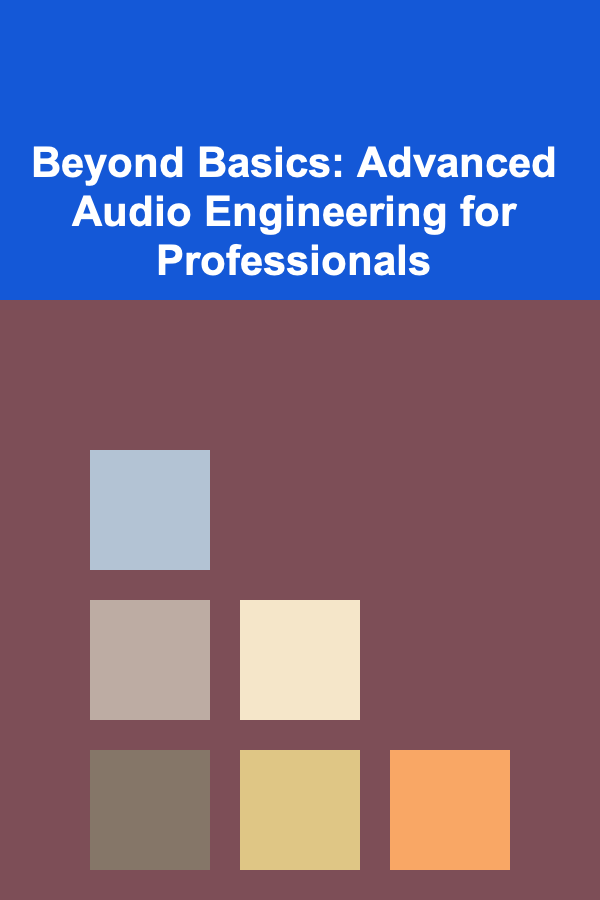
Beyond Basics: Advanced Audio Engineering for Professionals
ebook include PDF & Audio bundle (Micro Guide)
$12.99$8.99
Limited Time Offer! Order within the next:

Audio engineering is a dynamic and evolving field that demands both technical expertise and creative vision. For professionals who have already mastered the basics, the next step is to delve into more advanced techniques, tools, and workflows that can elevate their craft. Whether you're working in music production, film sound design, or any other audio-related field, advancing your audio engineering skills requires an in-depth understanding of acoustics, advanced signal processing, spatial audio, and mastering techniques. This guide explores the advanced concepts and practical applications that professional audio engineers need to master in order to stay at the top of their game.
Advanced Signal Processing
A. Dynamic Range Control
Dynamic range is the difference between the loudest and quietest parts of an audio signal. While compression is a fundamental tool in managing dynamic range, professionals need to understand advanced techniques that go beyond basic threshold/ratio settings.
- Multiband Compression: This technique involves splitting the signal into different frequency bands and applying compression independently to each band. This allows for more precise control over specific elements of a mix (e.g., taming bass without affecting the treble). A multiband compressor is especially useful for complex sounds, like full mixes, or instruments with wide-ranging frequencies (e.g., vocals, electric guitars).
- Parallel Compression: Also known as New York compression, this technique blends a heavily compressed signal with an uncompressed signal. It allows engineers to maintain dynamic control while preserving the natural impact and tone of the original recording. This is particularly useful for drums, vocals, and full mixes, adding punch without sacrificing clarity.
- De-Essing: In vocal recordings, sibilance (the "s" and "sh" sounds) can be harsh and distracting. Advanced de-essing involves using dynamic EQ or multiband compression to selectively reduce the volume of high frequencies, targeting only the sibilant sounds, rather than affecting the entire track.
B. EQ Strategies for Professional Mixes
Equalization is a powerful tool, but professional audio engineers need to take an advanced approach to ensure their mixes sound polished and cohesive.
- Surgical EQ: This involves using narrow-Q (bandwidth) cuts or boosts to precisely shape specific frequencies. It's especially useful for removing problematic frequencies, such as resonant boxiness in a guitar or harshness in a vocal. By cutting out only the offending frequencies rather than broad tonal changes, you can retain the natural character of the sound.
- Harmonic EQ: Some advanced EQ techniques aim to enhance the harmonic content of an instrument or voice rather than just altering frequency balances. Using harmonic EQ plugins can help to add warmth and depth to certain elements without resorting to traditional boosting. For example, adding harmonics to a vocal track might help it sit better in the mix without artificially increasing the volume.
- Mid/Side EQ: This technique separates the stereo image into the Mid (mono center) and Side (stereo information) components, allowing you to make EQ adjustments to each independently. By using Mid/Side EQ, you can enhance the clarity of the vocals in the center while maintaining the stereo width of the background instruments.
Advanced Recording Techniques
A. Microphone Techniques and Placement
Advanced audio engineering involves using nuanced microphone techniques to capture the most accurate and impactful recordings. These techniques require a deep understanding of acoustics, mic characteristics, and room dynamics.
- Stereo Microphone Techniques: Techniques like XY, AB, and ORTF are commonly used for stereo recording. These methods capture a sense of space and dimension. The XY technique uses two directional microphones placed in a coincident array, creating a natural stereo image with minimal phase issues. The ORTF (Office de Radiodiffusion-Télévision Française) method places two cardioid microphones at a 110-degree angle, mimicking the human ear's stereo perception.
- Room Miking: For natural-sounding recordings, especially in orchestral or acoustic settings, room mics are often used to capture the ambiance and reflections of the space. The goal is to blend the close mics with the room mics to create a sense of depth and dimension. Techniques like "Blumlein" and "Mid/Side" can help engineers capture both direct and ambient sound sources in a way that retains natural warmth and space.
- Phase Considerations: One of the most important factors in advanced microphone techniques is understanding phase relationships. When multiple microphones are used, slight timing differences can lead to phase cancellation, where certain frequencies are diminished or entirely canceled out. Audio engineers must be vigilant about phase coherence, especially when using multiple microphones to capture a single sound source.
B. Advanced Instrument Techniques
In addition to traditional mic placement, advanced engineers often utilize creative methods to capture unique sounds and add layers to a recording.
- Contact Microphones: These are placed on an instrument's body or other surfaces to capture the vibrations directly from the object. This is particularly effective for instruments like electric guitars, snare drums, or even unconventional objects like glass bottles or wood panels.
- Binaural Recording: Aimed at replicating the experience of natural hearing, binaural recording uses a pair of microphones positioned to mimic human ear placement. This technique is often used for immersive experiences, such as virtual reality soundscapes or high-fidelity headphone mixes. The result is an intensely realistic stereo image, often best experienced with headphones.
Spatial Audio and 3D Sound Design
With the rise of immersive media experiences like virtual reality (VR), augmented reality (AR), and 3D audio in gaming, audio engineers must develop new skills to craft spatial audio experiences.
A. Ambisonics
Ambisonics is a full-sphere surround sound technique that captures and plays back audio in all directions. It differs from traditional surround sound, which is usually based on a fixed speaker layout, by capturing a soundfield in 360 degrees (including height). Ambisonics is essential for VR and 3D audio, as it allows the listener to experience sound from every direction, regardless of their position.
- Encoding and Decoding: To record in Ambisonics, specialized microphones or a spherical microphone array is used. These microphones capture the full soundfield, which is then encoded into a format suitable for playback. Decoding processes, such as using binaural plugins or speaker arrays, re-create the sound environment for the listener.
- Tools for Ambisonics: Audio engineers working with Ambisonics rely on specific plugins and DAWs that support higher-order Ambisonics (HOA), which improves the resolution and accuracy of spatial audio. Tools like the "AmbiX" format in Reaper or "SoundField" plugins are commonly used for creating these immersive environments.
B. 3D Audio in Gaming and Film
3D audio techniques are increasingly important in gaming and film production, where the sound is used to enhance immersion and realism.
- HRTF (Head-Related Transfer Function): HRTF simulates the way the human ear perceives sound coming from different directions, including distance and angle. For audio engineers, HRTF is used in spatial audio algorithms to make sounds appear as though they're coming from specific locations in 3D space, improving immersion in games and VR environments.
- Object-Based Audio: Rather than assigning audio to fixed channels, object-based audio allows sound sources to be placed anywhere in the 3D sound field. In film and video games, this method gives more flexibility, enabling sound to move dynamically as characters or objects shift position. Tools like Dolby Atmos, DTS:X, and Auro-3D allow engineers to mix and render object-based audio.
Advanced Mastering Techniques
Mastering is the final stage in the audio production process, and while many of the core principles remain the same, professionals must adapt their approach to meet the demands of modern playback systems.
A. Loudness Normalization and Dynamic Range
With the rise of streaming platforms, loudness normalization has become a critical factor in mastering. Streaming services such as Spotify, Apple Music, and YouTube adjust the volume of tracks to ensure consistency across a playlist or album. Advanced mastering engineers now need to ensure that their mixes fall within specific loudness standards, typically measured in LUFS (Loudness Units Full Scale).
- LUFS Targeting: Engineers aim to achieve an average loudness around -14 LUFS for most streaming platforms, avoiding overly loud mixes that would be adjusted downward, leading to a loss of dynamics. At the same time, ensuring the track doesn't fall too far below this standard prevents it from sounding too quiet in comparison to other tracks.
- True Peak Limiting: Unlike traditional peak limiting, which only controls the loudest transients, true peak limiting accounts for digital clipping that may occur due to inter-sample peaks. By applying true peak limiting in the mastering phase, engineers can prevent distortion on different playback systems, especially those with high-definition audio output.
B. Stereo Enhancement and Width
In mastering, ensuring that a track's stereo image is balanced and wide can make a significant difference in its overall impact. Advanced techniques for stereo enhancement include:
- Mid/Side Processing: This technique involves processing the mid (mono) and side (stereo) components of a mix separately. This allows for more precise control over the spatial aspects of the track, enabling adjustments to the stereo width, depth, and balance.
- Stereo Imager Plugins: These tools allow for fine-tuning of the stereo field, enhancing the width without negatively affecting phase coherence. However, excessive widening can result in phase issues that may cause the track to sound unnatural when played on mono systems.
Conclusion
Advanced audio engineering requires not only technical skill but also a deep understanding of the creative possibilities that sound offers. By mastering sophisticated signal processing techniques, refining recording practices, leveraging spatial audio technologies, and applying high-level mastering skills, audio professionals can elevate their craft to new heights. As technology continues to evolve, staying on top of these advanced methods will allow engineers to push the boundaries of what's possible in the world of sound. Whether you're working in music, film, gaming, or VR, embracing these advanced techniques will give you the edge in an increasingly competitive industry.

How to Create a Dream Closet on a Budget
Read More
How to Host a Dinner Party with a Simple Yet Elegant Menu
Read More
How to Style Your Christmas House Window Decorations
Read More
Make Money by Developing AI Chatbots with Deep Learning
Read More
The Customer Insights Analyst's Guide: Unlocking the Power of Consumer Data
Read More
How To Warm Up Your Voice Before a Speech
Read MoreOther Products

How to Create a Dream Closet on a Budget
Read More
How to Host a Dinner Party with a Simple Yet Elegant Menu
Read More
How to Style Your Christmas House Window Decorations
Read More
Make Money by Developing AI Chatbots with Deep Learning
Read More
The Customer Insights Analyst's Guide: Unlocking the Power of Consumer Data
Read More